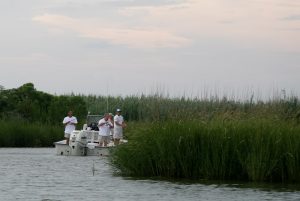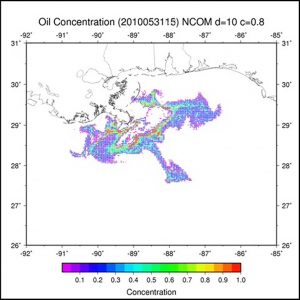Hurricanes and Oil Spills: Looking Back for Better Predictions
– September 10, 2012
Oil-spill science is not strictly business, it’s personal, too. The Deepwater Horizonoil spill felt very personal to Dr. Patrick Fitzpatrick a Mississippi State University (MSU) scientist researching storm surges, who is also an avid saltwater fisherman living in south Louisiana.
He kept close tabs on the situation unfolding “in his backyard”. He directed several research projects that investigated oil transport in specific regions along the Gulf Coast, modeling the influence of weather systems and the potential impacts of hurricanes, on the movement of the oil.
“While the oil spill was indeed a tragic and environmental disaster, the impact could have been worse. Fortunately, the weather during the event was fairly benign, devoid of any landfalling hurricanes.”- P. Fitzpatrick
Fitzpatrick noticed that in first six weeks of the event, the oil transport had preferred routes, impacting some areas while other areas such as Lake Pontchartrain, Lake Borgne, and the marsh to their east stayed relatively oil-free. Supported by several Gulf of Mexico Research Initiative (GoMRI) grants, Fitzpatrick and his team – in the first phase of their research – identified late June to early July 2010 as a period of scientific interest. During this time, oil briefly impacted the Rigolets, Lake Borgne and the western Mississippi coast, representing the innermost penetration of oil pollution east of the Mississippi River. Fitzpatrick developed an oil spill simulation for the June 20to July 10 time period incorporating meteorological and ocean data to help understand the influences on oil movement.
For the second phase of this study, the research team expanded the oil spill simulation to cover the period of May 25 to July 31. Because ocean currents and weather processes influence the movement of oil, researchers tested a trajectory model integrating weather data which suggested that oil movement could suddenly be altered by any low pressure system in the Gulf of Mexico.
Fitzpatrick says the movement of the spill was actually influenced by Hurricane Alex which made landfall in Mexico and another non-tropical low pressure system which pushed more oil onshore during July.
“Our oil spill modeling efforts and analysis, as well as storm surge scenario simulations, suggest a landfalling hurricane could have transported large amounts of oil in the environmentally sensitive estuary systems.”- P. Fitzpatrick
From this research, Fitzpatrick and his team created a trajectory model which can be used in any future pollution events. They also worked on a database of the oil impacts. The database will help validate the model, but also will be useful to other scientists. Their research findings have been submitted to the International Journal of Remote Sensing.
Fitzpatrick, an associate research professor at MSU’s Geosystems Research Institute, became interested in meteorology as a young boy from his time fishing on a boat with his father and learning the importance of being constantly alert to changing weather conditions. Dr. Fitzpatrick received his B.S. and M.S. degrees in Meteorology at Texas A&M University and his Ph.D. in Meteorology from Colorado State University.
He and his team, consisting of MSU research associates Christopher Hill, Haldun Karan, and Yee Lau were based at the John C. Stennis Space Center on the Gulf Coast. Read more about their GoMRI-funded research:
- The Influence of Weather and Ocean Processes Using Numerical Modeling on the Fate and Transport of the Deepwater Horizon Oil Spill Year One Block Grant – The Northern Gulf Institute
- OIL: Community Earth Modeling System for the Northern Gulf of Mexico Year One Block Grant – The Northern Gulf Institute
- Integrated Assessment of Oil Spill Year One Block Grant – The Northern Gulf Institute
- Oil Spill Impact along the Alabama Coastal Areas Year One Block Grant – The Alabama Marine Environmental Science Consortium
This research was made possible by a grant from BP/The Gulf of Mexico Research Initiative. The GoMRI is a 10-year, $500 million independent research program established by an agreement between BP and the Gulf of Mexico Alliance to study the effects of the Deepwater Horizon incident and the potential associated impact of this and similar incidents on the environment and public health.
© Copyright 2010- 2017 Gulf of Mexico Research Initiative (GoMRI) – All Rights Reserved. Redistribution is encouraged with acknowledgement to the Gulf of Mexico Research Initiative (GoMRI). Please credit images and/or videos as done in each article. Questions? Contact web-content editor Nilde “Maggie” Dannreuther, Northern Gulf Institute, Mississippi State University (maggied@ngi.msstate.edu).







